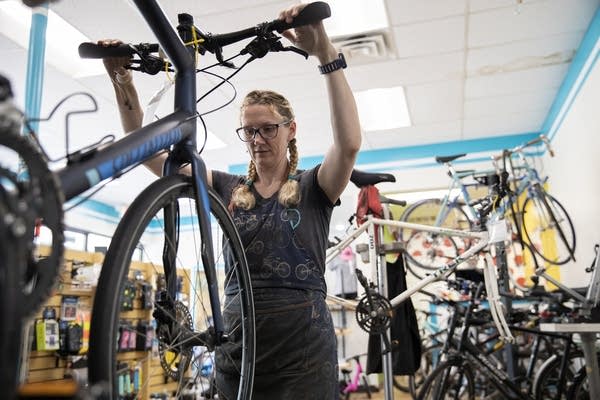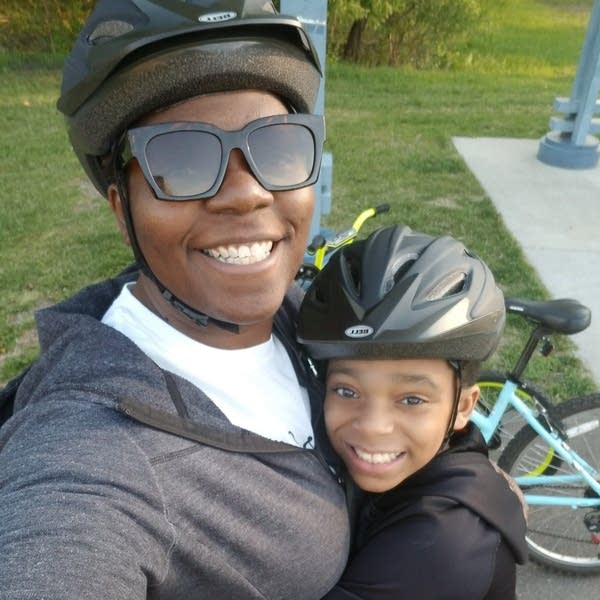Sales boom, factory shutdowns leave bikes in short supply amid pandemic

Go Deeper.
Create an account or log in to save stories.
Like this?
Thanks for liking this story! We have added it to a list of your favorite stories.
Sonya Lewis has big plans for when her older son comes to visit.
“We'll have all of our bikes and we're going to go on, like, a huge family trek. And I'm super excited about that,” she said.
Heading into 2020, Lewis, who lives in Plymouth, Minn., hadn’t owned a bike in years. But when the pandemic closed gyms and so many other parts of daily life, she started looking for a way to get outside and exercise with her two sons who still live at home.
So, she began searching for bicycles.
Turn Up Your Support
MPR News helps you turn down the noise and build shared understanding. Turn up your support for this public resource and keep trusted journalism accessible to all.
She tried several stores “and could not find not one single, solitary bike. I went to, like, several Targets, several Walmarts, whatever. And I wasn't really looking for anything extra-expensive; it was just more for recreation.”

Lewis wasn’t alone.
Since the start of the pandemic, there’s been an international boom in bike sales as people seek an alternative to public transit or the gym — or simply a way to get out of the house while maintaining social distance.
Lewis eventually found bikes, helmets and bike locks for herself and her middle son through a Twin Cities program called Bikes 4 Essential Workers.
It sprang up in part to give essential workers a way to get to their jobs. Organizers of that program say demand for bicycles far outstrips supply.
It’s the same story at bike stores across Minnesota. At Seven Spokes Bike Shop in St Paul, owner Alicia Vin Zant estimated her sales have doubled compared to last summer.
Earlier this year, her stock of bikes started running low. She recounted thinking, “OK, I'll just order bikes back, order back-order, back-order. Oh, this is becoming a problem. Like, well, if I can't sell bikes, it's not the end of the world. I can still fix bikes. And that's OK. Well, now at the point where I can't get parts now.”
Those parts are needed as Vin Zant said she’s seen customers dusting off 20-year-old bicycles in their garages and bringing them in for long-overdue tuneups.
On top of the high demand for bicycles and parts, both are in short supply.

Rich Tauer is president of Quality Bicycle Products. It’s headquartered in Bloomington, but it manufactures and distributes bike parts worldwide.
Tauer said bicycle sales initially dropped off when the pandemic hit, then sprang back big time starting in late March as bike shops were deemed essential. So demand was up, but “the supply chain doesn't react that quickly,” Tauer said.
“So the amount of inventory that was either in stock or on order to come during this time is, generally speaking, what's available. I mean, you can boost it a little bit, but it takes a long time to boost it a lot,” Tauer said. “And whether it be bicycles or bicycle parts like tires or chains, those things are just slowly starting to run out at this point.”

The challenge is that many of the world’s bicycle parts are made in Asia — largely in China. Many of those factories lost about two months’ production and shipping time at the start of the year due to the coronavirus. Minnesota shops are feeling that shortage now.
Those factories are up and running now, Tauer said, but they need raw materials to make those tires and frames. He predicts supply will be playing catch-up through the fall, if not longer.
But new bicycles are still trickling in.
Charles Cowan, the general manager for Behind Bars Bike Shop and Michael’s Cycles in Minneapolis, Prior Lake and Chaska, said the dozen or so bikes his three stores get weekly are selling out within days, usually still in the box. Both the demand and supply issues in the bicycle business present a challenge for bike shop owners as they look to the fall and ordering for next year. As Cowan looks to the future, he’s also thinking about the potential for many more cyclists on the streets and bike trails of Minnesota for years to come.
“What I really hope is that all these people that bought these bikes actually fall back in love with biking, and start to pass it on [so that] more people continue a healthy lifestyle,” he said.
That’s how it's been so far for Sonya Lewis.
Lewis said that when she got on her new bike, she felt like a kid again, tooling around the neighborhood with her friends. Now, she hopes to make new family memories, especially with her youngest son.
“I want him to be able to look back into it. But I think a back can have memory of him and his mom doing something together, like to see his mom active, to see his mom on a bike.”
Dear reader,
Political debates with family or friends can get heated. But what if there was a way to handle them better?
You can learn how to have civil political conversations with our new e-book!
Download our free e-book, Talking Sense: Have Hard Political Conversations, Better, and learn how to talk without the tension.



